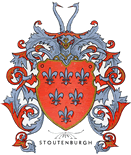
Be sure to check out our maps page for maps of early New York as well as our illustrations page for visual depictions of life in early New York.
New York was originally settled as a colony of the Netherlands following Henry Hudson’s exploration in 1609 of the river later named for him. In 1624 the Dutch established Fort Orange at modern Albany as the first permanent European settlement in New York. One year later, New Amsterdam was established at the foot of Manhattan Island. To legalize the settlement, Peter Miniut, the Dutch governor, paid the Indians in merchandise worth 60 Dutch guilders (about $24.)
The Dutch established several settlements along the Hudson, mostly for the purposes of trade. However, they recognized the need to establish farms to support the trading industry. The first families that the Dutch West India Company brought to settle in New Amsterdam and Rensselaerwyck were primarily Huguenots. Even though the families were fleeing persecution by the French, the conditions in the New World were very primitive. The Dutch West India Company recognized that the head of a household was willing to work harder and defend the town if he had an interest in his residence.

The Dutch West India Company issued land patents to residents provided they met certain requirements. At the end of a period, a man could hold title to land. For most men, this was something that was not possible in Europe at this time. Thus, men who did not have an opportunity to own land in the Netherlands, became landowners in the New World.
When an English fleet sailed into New York harbor in 1664, Peter Stuyvesant, the governor, surrendered without a fight. Although controversy ensued for several years, the colony was firmly in English hands by 1669. Under the English it was renamed New York, for the Duke of York. Despite this change in ownership and sovereignty, the English crown recognized most of the patents that the Dutch West India Company granted prior to 1664. The various English Governors continued to grant land patents to groups of men who together improved the land. The Nieuw Haarlem (New Harlem) Patent, Schenectady Patent, and the Great Nine Partners Patent are examples of such patents. In some cases the Dutch West India Company issued a very large land grant to a single man. Such was the case with the Van Rensselaer family and Rensselaerwijk. The English king also made large land grants that were known as manors, such as the Manor of Cortlandt, Manor of Livingston, etc.

The European war between France and England had its counterpart in North America. The French, established along the St. Lawrence and in Quebec, made a number of forays into northern and central New York. The strong Five Nations federation of the Iroquois aligned itself with the English in New York and New England because of aid given earlier by the French to the rival Algonquian. This warfare discouraged settlement beyond Albany. The military situation was brought to a conclusion in 1763 by the Treaty of Paris, which confirmed English dominance of the New York region. A gradual but steady movement of settlers from New England was the beginning of New York’s population explosion. The New Englanders moved across the borders of Connecticut and Massachusetts, some remaining on the east bank of the Hudson, others passing through Albany to the interior.
In 1698 the colony’s population was about 18,000, two-thirds of it concentrated in and around New York City. By the eve of the American Revolution, it had grown to 163,000, with the concentration nearly exactly reversed, but New York still ranked only seventh among the American colonies. Dutch culture remained strong in New York City and in Albany, while most of the settlements in the interior had a flavor and dialect of the New England Yankee; there were also several German communities. This emerging pattern of cultural heterogeneity was later to have a considerable influence on the politics of the state, as were the waves of immigration from Europe that followed the war and continued well into the 20th century.

